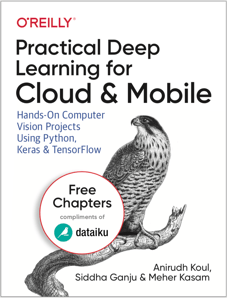If this month’s Google I/O conference is any indication, then incorporating machine learning (and deep learning) into existing products and processes to make them more efficient or useful is the future. From healthcare to sales, deep learning has wide applications; and with last week’s launch of Hailo's newest deep learning chip, they will only get wider.

Yet with an already well-documented data talent shortage, how will businesses keep up with the trend? Education is one critical component, and it doesn’t stop with a degree or university education. But diving in to deep learning (DL) in particular can be intimidating, even for those who have a data-minded background.
 Go deeper and get hands-on with deep learning in O'Reilly's latest ebook.
Go deeper and get hands-on with deep learning in O'Reilly's latest ebook.
DL vs. ML vs. AI: What’s What?
Talking about deep learning is increasingly complex because it’s often used alongside (or even interchangeably with) the terms machine learning and artificial intelligence (AI).
First here is what you need to know: DL is a subset of ML, which is itself a subset of AI (this graph helps explain this nuance).
Before the start of machine learning in the 80s, business decision rules were mostly hand-coded sets of instructions based on the knowledge of business experts. With machine learning, those rules are inferred from the previously collected data — the business expertise plays a role (and is in fact required) for the feature engineering part.
Basically, the business expert needs to determine which factors may impact the results you want to predict, and the algorithm automatically selects the optimal way to combine these factors. You "train" a model. The key question is: based on my data, what is the best rule I can create to solve my business problem?
What Are the Specificities of DL?
A DL algorithm is able to learn hidden patterns from the data by itself, combine them together, and build much more efficient decision rules. That’s why it can deal with problems that a human brain could not understand — all the value of deep learning is this automatic pattern identification capability. This means handling more complex problems, such as understanding concepts in images, videos, texts, sounds, time series, and all other unstructured data you think of.
 A Visual representation of computer vision (in this case, the image is an X)
A Visual representation of computer vision (in this case, the image is an X)
But don’t think deep learning as a model learning by itself. You still need properly labeled data, an evaluation of the model results, and of course an evaluation of the business value it will bring! Actually, the lack of precisely labeled data is one of the main reasons DL can have disappointing results in some business cases.
Of course handling more complex data means more complex algorithms. And to extract general enough complex patterns from complex data, you will need lots — read: LOTS — of examples (much more than an ML model). Typically, you need millions of labeled images for a classification task.
Since the feature engineering is automatically done by the machine, the interpretation is not obvious for a human and DL “black-box” decision rules can be rejected by business analysts. In fact, DL model interpretability is one of today’s biggest DL research challenges.
That means don’t throw all your classical ML models out the window! In most classical data-related problems, ML approaches still do a better job than DL since they don’t involve unstructured data. For example, here’s a simple illustration: I want to go from Manhattan to Brooklyn/Boston/Paris: walk, car, train, plane? It comes down to a simple compromise between cost and time spent (cost > model designing time, time spend > accuracy). Flying from Manhattan to Brooklyn is the equivalent of using a DL model for a “simple” problem (that is to say, it's not efficient at all).




